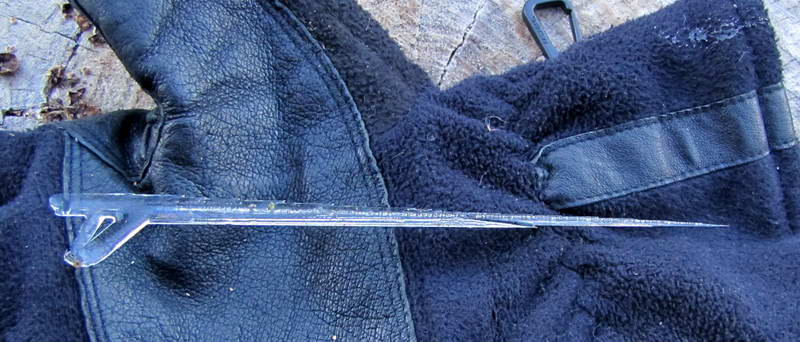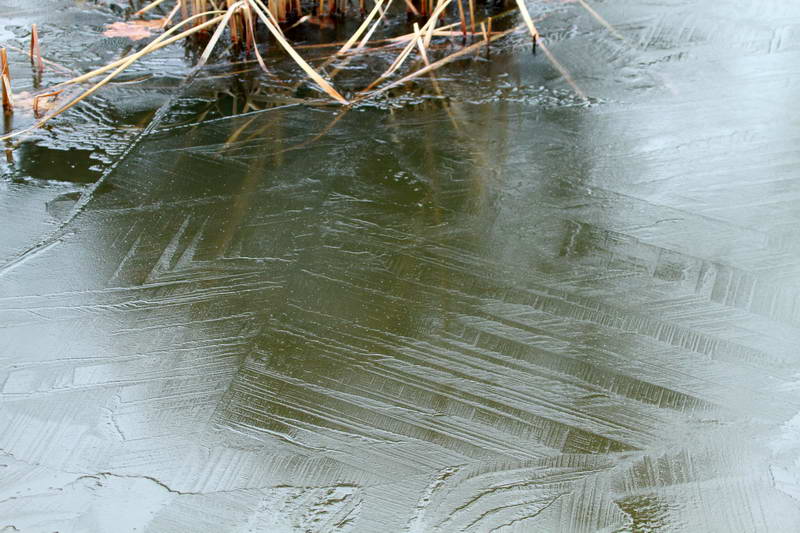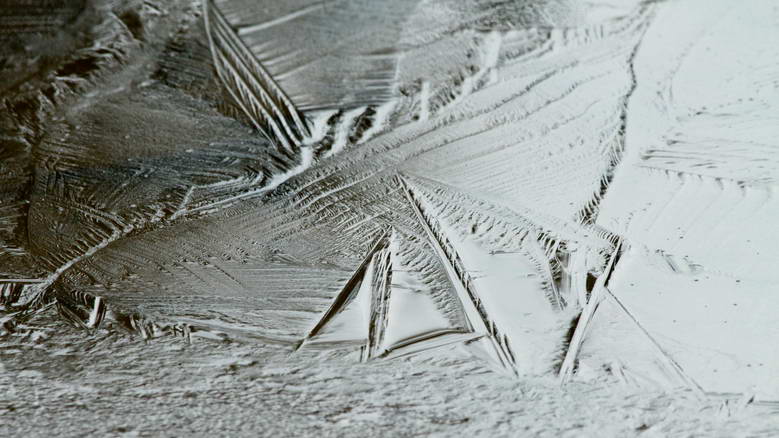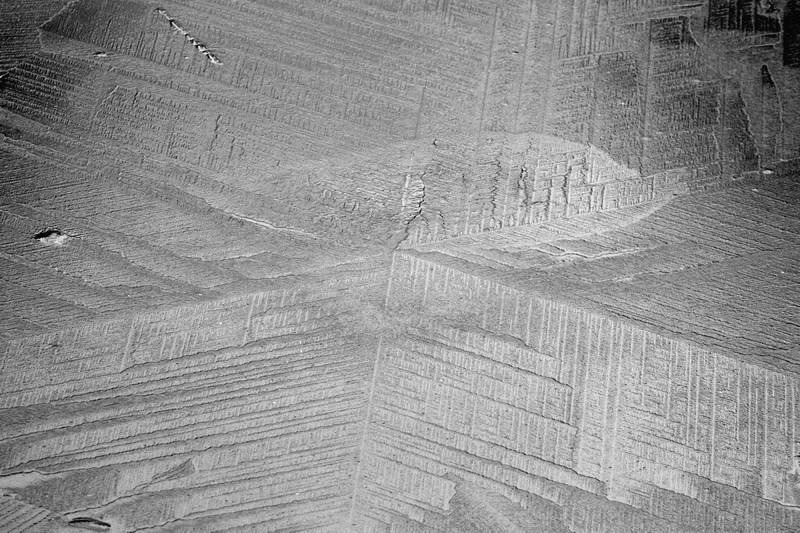An Approximate View of Initial Ice Formation
Liquid to Solid, close up:
Ice is a crystalline solid. Ice crystals grow by water molecules fitting into the surface of an existing ice crystal so they are all aligned the same way. With an existing ice sheet in place, ice forms at the ice-water interface at the bottom of the ice sheet. To fit into an ice crystal, the molecule has to be moving/wiggling slowly enough that it does not bounce off and it is able to hook up with dangling hydrogen bonds in the local crystal structure. In simple terms this means that the water molecules that contact the ice surface slowly tend to end up as ice and the faster ones stay on the water side of the ice-water interface. Molecules in ice at the freezing point have considerably less energy involved in wiggling than molecules in the liquid state where they are free to roll and slide around in addition to wiggling. This greater freedom means that molecules going from a solid to liquid phase require some extra energy. This is called latent heat and amounts to 80 calories per gram of water. This is higher than most other substances and accounts for how long it takes ice to form and how long it lasts in thaw conditions. For a YouTube video on simulated ice melting click Here. There are several other videos similar to this.
Note1: thinking of molecules as 'fast' and 'slow' is easy to visualize but not what really happens. Molecules are constantly bumping into each other and each collision changes its energy ('speed') and, given the very small distances involved, collisions happen at a very high rate compared to what we see in the macro world. Also, ice at 32 degrees in contact with water at 32 degrees is constantly having some molecules get bumped off by the ice while the same number of water molecules are attaching to the ice surface. The fraction of ice and water stay the same. Ice is more likely to be bumped off areas of high curvature (corners) and more likely to be deposited on areas with little or concave curvature. Different parts of the crystal have different affinities. The C axis faces are 'smoother' and less easy for a water molicule to find a happy home on. The three A axies are much more condusive to attachment. This is what drives dendritic growth in supercolled water.
Note 2: In water near freezing, water molecules are groups of several H20 molecules held together by hydrogen bonding. This accounts for the relatively high melting and boiling points of water as well as many of the other odd properties of water and ice.
Nucleation and Supercooling:
In cold weather, when there is no ice present to provide an easy parking place for slow water molecules, the water will cool to below 32° without freezing. This is called supercooling. In very pure water it is possible to cool bulk water to many degrees below freezing. Lake water contains large numbers of small particles including suspended sediment, bacteria, and the like. In cold conditions the air overhead may have small ice crystals in it. When the water gets supercooled from a few hundredths of a degree to a couple degrees, ice will start to nucleate. Ice particles require the least supercooling (virtually none). Once ice is present in still water ice quickly propagates through the super cooled water at the surface as blade like crystals (dendritic growth). These blades can be seen on a puddles starting to freeze on a cool evening. This is called 'fast growth'
The rate of growth is constrained by the amount of supercooling in the water, the rate that the latent heat can be conducted away through the still water (water is a relatively poor conductor) and conducted and radiated into the air from the top surface of the growing crystal (assuming it is floating on the surface).
Formation of the initial ice sheet (Primary Ice)
In quiet, supercooled water, growth takes place almost completely on the A axes. That is to say the needles propagate away from the nucleation site in one or more A axis directions. A axis growth is faster than growth in the C axis by a factor of 50 or so. The reason for this is the water molecules find it much easier to find a place to park at the 'rougher' A axis at the corner corner between the prism planes than on the 'smooth' basal plane. (Click Here for an illustrated explanation). The prism planes are also smooth and do not grow any where near as fast as at the corners. This favors needle like crystals because the small size of the solidification front at the tip of the needle warms the supercooled water less allowing the needle to grow quickly into the colder supercooled water ahead of it.
If you have ever looked at the crystals forming in a puddle you know they are really a long narrow blade rather than a needle. The width of the blade comes from A axis growth off the sides of the needle in the other A axis directions. The blade has a solidification front that runs all along the edge of the blade, dumping more latent heat into the nearby water, warming it more than the much smaller tip speeding through the colder supercooled water. If cooling conditions are mild relatively few blades start and they grow quite long (2+feet in many cases) before they run into each other. These blades will have straight sides. If cooling is stronger (good radiational cooling and/or a cold air temperature) branching instability will occur which starts with teeth on the sides of the blade which develop into side branches. The blades tend to be wider and to have curved sides.
Formation of primary ice types
 A 6" ice needle that grew on the supercooled surface of a puddle. Its narrowness and straight sides indicated that it grew in conditions that were near freezing. Needles are the first step in the formation of P1 and P2 ice.
A 6" ice needle that grew on the supercooled surface of a puddle. Its narrowness and straight sides indicated that it grew in conditions that were near freezing. Needles are the first step in the formation of P1 and P2 ice.
P1 ice forms in quiet water with moderate temperatures. The blades grow across the water until they run into each other. After that, dendrites (branches and branches on branches) grow off the blades to fill in the remaining water surface in between the needles. The blades tend to stay on the surface not only because the float but also that is where the supercooled water is. In moderately cool conditions the layer is thin and the amount of supercooling is low. The resulting ice will be have a crystal (grain) size ranging from a few inches to, occasionally, as much as several feet. The needles typically form with a C axis that is not vertical. The dendritic primary ice that fills in-between the needles has a C axis that is close to vertical so, overall, the ice has a mostly vertical C axis orientation.
 P1 ice surface after the areas between the initial needles fills in with dendritic growth.
P1 ice surface after the areas between the initial needles fills in with dendritic growth.

P1 ice, scale: picture about 8" across.
 P1 ice with all three 'A' axis directions shown (like a very large snowflake). The angle between the axies is 60 degrees. It looks different than 60 degrees in the picture because the picture was taken at a low angle to the surface of the ice. Scale: Picture about 14" across.
P1 ice with all three 'A' axis directions shown (like a very large snowflake). The angle between the axies is 60 degrees. It looks different than 60 degrees in the picture because the picture was taken at a low angle to the surface of the ice. Scale: Picture about 14" across.
S1 ice: Once the ice sheet is established, supercooled water can't form under the sheet except very close to the ice interface and at the very low amounts of supercooling needed to drive the congealation process that thickens the ice. Ice sheet thickening is limited mostly by how fast heat can be conducted away from the bottom of sheet rather than how fast ice can form in supercooled water. This means ice will thicken at the same rate if the C axis is vertical or horizontal. This is called 'slow growth'. S1 ice is often called 'large grain ice'
P2 ice forms on still water if the air is pretty cold (10 deg??), the water supercools more and deeper and more nucleation occurs (more blades) resulting in medium to large crystal sizes and a somewhat more random C axis orientation (still mostly near vertical however).
Small grained ice (P3 and P4)
P3 ice forms in rivers with enough turbulence to mix the supercooled water to much deeper depths, often to the bottom. The turbulence is much more effective at removing heat from growing crystals. Ice that forms this way is called frazil and is in the form of small disks. The disk shaped form is round rather than hexagonal because, in turbulent water, with its strong convective heat conduction, the tendency to minimize surface energy by minimizing surface area plays a bigger role than in still water where needle/dendritic growth predominates. As the frazil disks grow they may form small branches on the edges as the ratio of area to perimeter increases and they are less able to dissipate the latent heat associated with the larger relative area of the disk. As the amount of frazil increases it may form a frazil slush (grease ice) on the surface. At some point the ice locks up and forms a rigid sheet.
P4 ice is formed when snow falls into water that is ready to freeze creating lots of closely spaced nucleation sites and a small grain size. This is different than frozen shush formed when snow falls on top an ice sheet and then gets saturated with water wicked up through cracks and holes in the ice sheet. This is called 'snow ice' and is a common form of superimposed ice (T1).
When lots of ice particles are available at the water surface (snow or flake ice on wavy lakes and frazel in rivers) the formation process there is some A axis growth growth in moderately supercooled water but the length of the needles is much shorter as there are so many nucleation sites. The grain sizes are smaller (typically 0.1" to 1"). P4 ice forms when snow is falling into the water as the surface cools to 32 degrees. This becomes S2 ice (often called 'small grain ice'). The C axis tends to be horizontal, especially near the surface.
On lakes and ponds without snow falling but some wind and ripples/waves, needles and flakes (needles with branches) form on the surface. They are broken up by collisions and wave action and they may get tangled up with each other into small rafts of several flakes. This creates lots of nucleation sites and allow the primary needles/branches to grow into others a short distance away, keeping the the crystal size small (typically less than an inch). This can play out in different ways depending on the size of the lake, the proximity to the downwind shore, the amount of wind and a couple other factors. Based on the standard classification system this is probably considered P3 ice. In my opinion, it should have its own category as the formation mechanism is quite different than either P3 or P4. More on ice formation in wavy conditions.
Secondary Ice
As we have seen, grain size is established in the thin primary ice layer, the general texture is preserved as the secondary ice grows on the bottom of the ice sheet. The formation process is called congealation and is 'slow growth'. The growth rate is controlled by the rate that latent heat can be conducted through the ice and into the air. This results in a relatively smooth bottom on the ice sheet and, assuming there is no snow on the ice, a uniform ice growth rate.
At a molecular scale dihydrogen oxide (H2O) molecules are coming and going from the ice-water interface as they park on the ice or leave the ice because they wiggle free or get bumped by another molecule. Unlike growth in supercooled water, any pointy places on the bottom of the sheet tend to be rounded because the ice molecules in the pointy area are being hit and knocked off more by the water molecules than is the case where the interface is flat or concave.
In general, grain size increases toward the bottom of the ice sheet. Crystals with a more vertical C axis, wedge out less vertical crystals with their more aggressive lateral growth on the A axis. This happens at a very small scale on the shallow groove that exists where the crystal boundary intersects the bottom of the ice.
Seeing the ice crystal structure:
When the primary ice first forms, the needles, dendrites, stacked needles and other features are usually easy to see because they have some vertical relief. This melts or sublimes off off the surface in a few days. The crystal structure can be hard to see for until the ice gets warmed significantly. After being warmed up, internal bubble sheets and vapor figures will make S1 ice easy to identify. In thaw conditions, grain boundary grooves will often melt into the surface and make all grain sized visible (we call this 'grain-textured ice').
It is common to see areas of large and small grain ice intermixed in an ice sheet. One way this happens is when an ice sheet is broken apart a little and refreezes. The picture half way down the Grain Size page shows a boundary between small and large grain ice. It appears that the large grain ice came after the small grain ice sheet broke up. This seems to be the more common case.
Other than curiosity, this does have a potential impact on ice travel. As is outlined on the Grain Size page, small grain ice (S2) weakens considerably more in thaw conditions than large grain ice (S1). The truth of the matter is you should not be out on ice that is thawed enough for this to be a problem. Having said that, all too many people break through well thawed ice. Often they go onto the ice in the morning after a cold overnight has hardened up the surface of what was a well thawed ice sheet yesterday. As the day progresses the surface rethaws leaving them on an ice sheet that will not hold their weight.
See Grain Size
See Ice Types page
See Ice Growth page
For further insight into ice crystal formation check out Kenneth George Libbrecht's website and books on snowflake formation.
Thanks to Dr Sam Colbeck for guidance on key aspects of the formation process.

